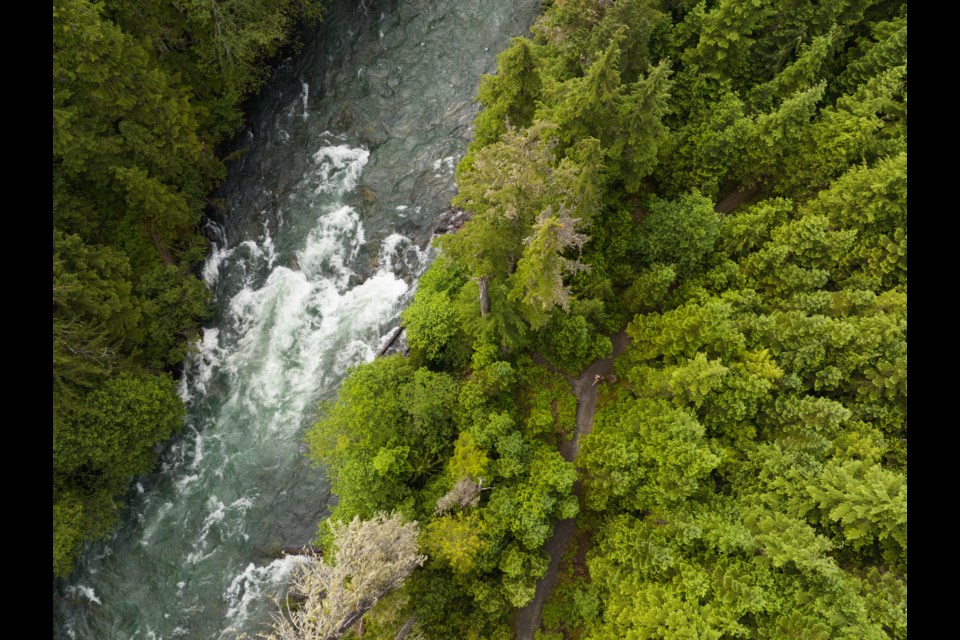A rainstorm is on the way, and it’s going to make for a wet weekend in the Squamish Valley.
“We are expecting quite a bit of rain,” said Matt Loney, a meteorologist with Environment Canada. “The rain will pick up tonight and tomorrow, take a short break Saturday night, and then come back stronger on Sunday.”
By the end of the storm, the Squamish Valley could see between 120 and 140 millimetres of rain.
“That’s just in the valley," Loney said. "If you head up into the mountains, there will be even more rain—maybe double the amount—and all that water will eventually flow into the rivers,” said Loney.
The Sḵwx̱wú7mesh Nation is watching the weather closely
The Nation has also issued a flood and safety advisory, asking residents to be careful around rivers and creeks via a Facebook post. The Nation said rivers will rise quickly from the rain expected to start Friday, Oct. 18, and continue through to Sunday, Oct. 20.
“The Nation is monitoring the situation and will continue to do so as conditions persist,” the advisory posted on Facebook said.
The message also asked everyone to stay clear of fast-moving water and riverbanks, which could become unstable.
District of Squamish crews on the ground
“Crews are checking creeks, drainage channels, and key areas for blockages,” said Christina Moore, the district’s communications director in an email to The Squamish Chief.
“They are also monitoring river levels, flood gates, and pumps through our online system and with in-person inspections.”
While no evacuation alerts are in place, the District warns that low-lying areas could experience some flooding. The District “will maintain contact with BC Hydro in the event that any spill notification from the Daisy Lake dam is issued.”
Will it be as bad as the 2022 flood?
This storm brings almost as much rain as the Dec. 2022 storm that flooded parts of downtown Squamish.
However, Loney said the risk this time is lower. “What made the 2022 storm so challenging was the high tide on Dec. 27. This time, we don’t have to worry about tides, which means the chance of flooding is smaller,” he said.
Flood watch in effect
The B.C. River Forecast Centre has issued a Flood Watch for the South Coast, including the Sea to Sky Corridor and nearby areas like Whistler, Sechelt, and Squamish. A Flood Watch means rivers could rise fast and may spill over their banks.
“For river levels and flood alerts, the River Forecast Centre is the go-to,” Loney said.
“But residents, especially those in areas like Paradise Valley, should keep an eye on the rivers and stay informed.”
Don’t forget the wind – clear your storm drains
On Sunday, strong winds could add to the challenges.
“While winds may not be a major issue early in the storm, we could see stronger winds from the ocean on Sunday. With many leaves still on the trees, there’s a chance they could clog storm drains,” Loney said.
“If you have a storm drain near your home, check it and clear any leaves you can to prevent flooding.”
For residents who need sandbags, the District has set up the usual sandbag station at Brennan Park. Sand and bags are available, but residents are asked to bring their own shovels to fill them. “There will be some shovels available to share, but we ask that they be left for the next person,” said Moore.
November is known for heavy rain
According to data, shared by the government of Canada, November is one of the wettest months of the year in Squamish, with an average of 383 mm of rain.
The atmospheric rivers—long streams of water vapour in the sky—are common on the coast according to Loney.
“We’ve already had a few hit the North Coast this year. This is the first for the South Coast, and it’s going to have an impact,” he said.
This kind of storm is normal for the area, but it still requires attention. “It’s like a river in the sky. When it runs into mountains, the water turns into rain. The higher the mountains, the more rain they get,” Loney said.
With lots of rain, wind, and rising rivers expected, it’s important for everyone to be ready. Keep an eye on weather alerts, check on nearby storm drains, and stay away from fast-moving water.
Bhagyashree Chatterjee is The Squamish Chief’s Indigenous affairs reporter. This reporting beat is made possible by the Local Journalism Initiative.




